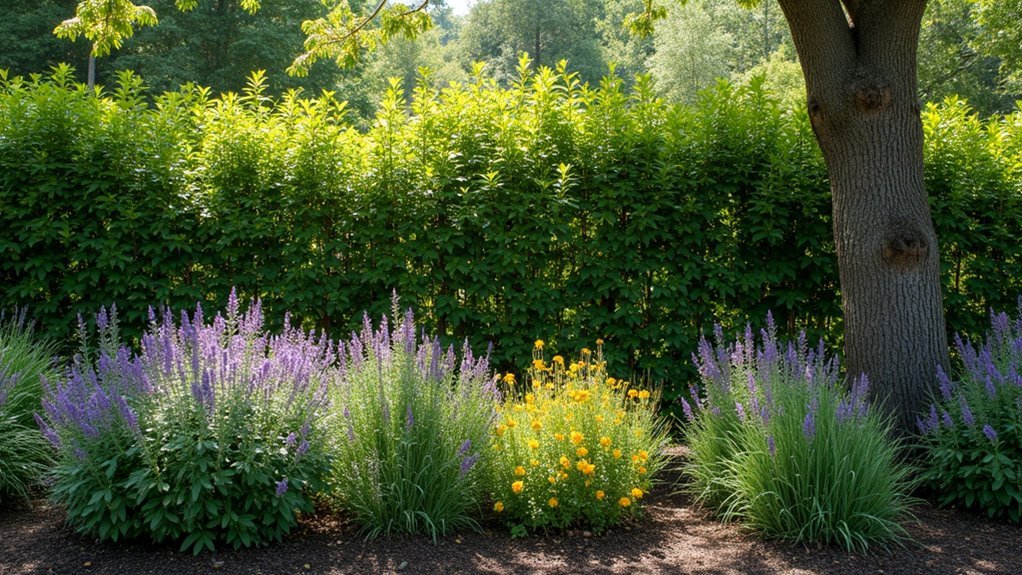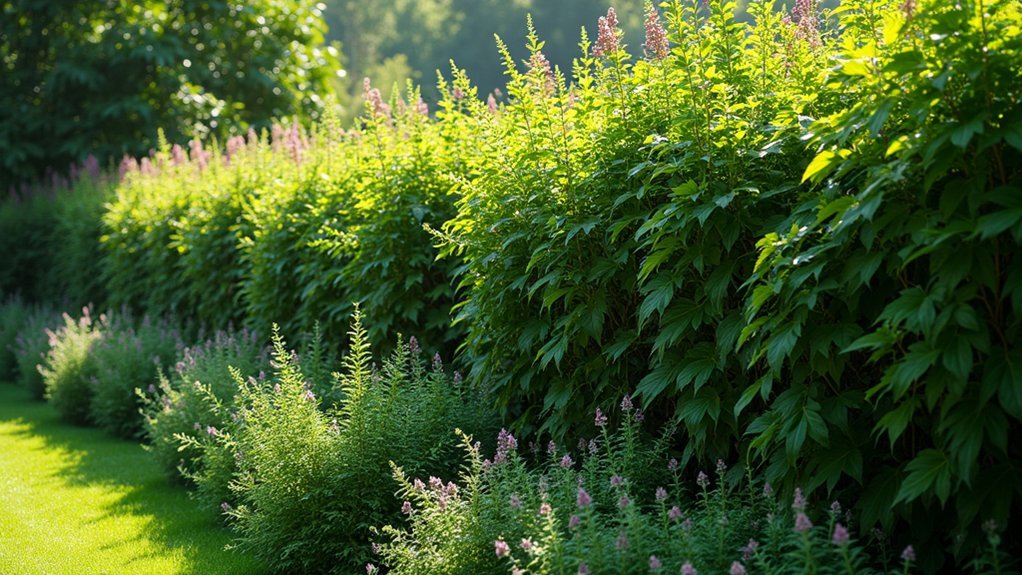For natural fencing, you’ll find Black Chokeberry, Red Twig Dogwood, and Common Ninebark offer outstanding performance. Black Chokeberry thrives in clay soils across zones 3-8, creating dense barriers when planted close together. Red Twig Dogwood’s fibrous roots penetrate compacted soil while providing winter interest. Common Ninebark forms robust boundaries with minimal maintenance while supporting wildlife. Plant these natives in fall or early spring for living borders that strengthen year after year.
Establishing Deep-Rooted Native Shrubs for Sturdy Natural Boundaries

When selecting plants for natural property boundaries, deep-rooted native shrubs offer remarkable stability and longevity that traditional fencing can’t match.
For clay-heavy or poorly drained sites, Black Chokeberry thrives in zones 3-8, while Red Twig Dogwood’s fibrous roots excel at penetrating compacted soil layers over time.
For maximum effectiveness, plant Common Ninebark 3-4 feet apart to create a dense barrier that also provides wildlife habitat.
Combine taller species like Elderberry with mid-height plants like Chokeberry for layered density. Many of the native shrubs featured at Deep Roots Natives can be integrated into your living fence design for a regionally-appropriate barrier.
After planting, apply 3 inches of pine straw mulch and trim back about one-third of the growth to encourage root development.
Establish deep roots with twice-weekly watering for the first six months, creating a living fence that grows stronger each year.
Root Management Techniques for Native Hedgerow Success
Although native plants typically require less maintenance than ornamentals, successful hedgerow establishment depends on proper root management from day one. You’ll need to prepare your soil thoroughly by removing existing weeds and adding organic matter to give your plants the best start. Many native species like Arctostaphylos spp. and Ceanothus spp. will thrive with minimal intervention after establishing their drought tolerance characteristics.
| Technique | Application |
|---|---|
| Physical Barriers | Install vertical plastic or metal barriers to contain spreading roots |
| Strategic Watering | Water deeply but infrequently to encourage downward root growth |
| Regular Pruning | Balance above-ground growth with root expansion by pruning during dormancy |
| Mulching | Apply 2-3 inches around plants to suppress weeds and retain moisture |
For ideal development, consider planting in fall (in temperate areas) or early spring (in colder regions) to maximize root establishment before demanding growing seasons. Remember to remove suckers promptly to prevent unwanted spread beyond your intended boundary.
Balancing Growth and Containment in Living Fence Systems

Creating a successful living fence requires carefully balancing robust growth with effective containment strategies. Native species like elderberry and serviceberry not only support local wildlife but also create effective natural barriers when properly managed. Living fences have historically served as protective barriers, with cultures like the Maasi utilizing acacia trees to secure their homes from intruders.
You’ll need to take into account growth rates when selecting plants to guarantee even development and reduce maintenance needs. Inosculation techniques, where branches are tied together to naturally graft, can greatly strengthen your living fence.
- Choose diverse plant species to prevent disease spread and enhance ecosystem resilience
- Implement proper spacing—close enough for density but allowing adequate airflow
- Establish regular pruning schedules to maintain shape and prevent overgrowth
- Combine deciduous and evergreen varieties for year-round coverage and seasonal interest
Frequently Asked Questions
How Long Before Native Plant Fencing Provides Full Privacy?
You’ll see varying privacy timelines: 3-5 years for fast-growers like white pine, 5-8 years for moderate species like viburnums, and 8-10+ years for smaller options. Climate and maintenance greatly impact these timeframes.
Can Native Plant Fences Deter Large Wildlife Like Deer?
Yes, you can deter deer with native plant fences using thorny species like hawthorn, dense thickets of red osier dogwood, or aromatic plants like bayberry. They’re most effective when planted in strategic layers.
Which Native Plants Work Best Near Swimming Pools?
Near swimming pools, you’ll want drought-tolerant natives like Bottlebrush, Banksia, and Kangaroo Paw. They’re chlorine-resistant, require less maintenance, and won’t drop debris. Yucca and native grasses also thrive in these sunny spots.
How Do Native Hedges Impact Home Insurance Rates?
Native hedges can lower your insurance rates when they’re fire-resistant and well-maintained, serving as firebreaks. However, they’ll increase premiums if overgrown or placed too close to structures, as insurers assess landscape fire risks.
Are There Native Plants That Won’t Attract Bees or Wasps?
Yes, you can plant Walter’s Viburnum, Awabuki Viburnum, or male-only Hawthorn cultivars. These natives attract fewer pollinators, especially when pruned to limit flowering while still providing dense, protective screening.
In Summary
When you choose native plants for natural fencing, you’re creating boundaries that benefit both your property and local ecosystem. Remember to monitor root systems regularly, prune strategically, and balance containment with healthy growth. Your living fence will mature into a beautiful, functional barrier that provides privacy while supporting local wildlife. With proper care, these native hedgerows will serve your landscape for years to come.





Leave a Reply